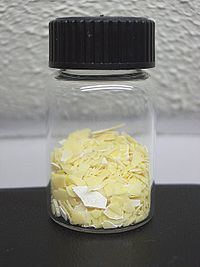Related compounds Molar mass 78.0452 g/mol Density 1.86 g/cm³ | Formula Na2S Melting point 1,176 °C | |
 | ||
Appearance colorless, hygroscopic solid | ||
How the ionic bond forms in sodium sulfide na2s
Sodium sulfide is the chemical compound with the formula Na2S, or more commonly its hydrate Na2S·9H2O. Both are colorless water-soluble salts that give strongly alkaline solutions. When exposed to moist air, Na2S and its hydrates emit hydrogen sulfide, which smells like rotten eggs. Some commercial samples are specified as Na2S·xH2O, where a weight percentage of Na2S is specified. Commonly available grades have around 60% Na2S by weight, which means that x is around 3. Such technical grades of sodium sulfide have a yellow appearance owing to the presence of polysulfides. These grades of sodium sulfide are marketed as 'sodium sulfide flakes'. Although the solid is yellow, solutions of it are colorless.
Contents
- How the ionic bond forms in sodium sulfide na2s
- Sodium sulfide
- Structure
- Production
- Reactions with inorganic reagents
- Uses
- Reagent in organic chemistry
- Safety
- References
Sodium sulfide
Structure
Na2S adopts the antifluorite structure, which means that the Na+ centers occupy sites of the fluoride in the CaF2 framework, and the larger S2− occupy the sites for Ca2+.
Production
Industrially Na2S is produced by carbothermic reduction of sodium sulfate often using coal:
Na2SO4 + 2 C → Na2S + 2 CO2In the laboratory, the salt can be prepared by reduction of sulfur with sodium in anhydrous ammonia or by sodium in dry THF with a catalytic amount of naphthalene (forming sodium naphthalenide):
2 Na + S → Na2SReactions with inorganic reagents
The dissolution process can be described as follows:
S−2 + H2O → HS− + OH−Sodium sulfide can oxidize when heated to sodium carbonate and sulfur dioxide:
2 Na2S + 3 O2 + 2 CO2 → 2 Na2CO3 + 2 SO2Oxidation with hydrogen peroxide gives sodium sulfate:
Na2S + 4 H2O2 → 4 H2O + Na2SO4Upon treatment with sulfur, polysulfides are formed:
2 Na2S + S8 → 2 Na2S5Uses
Sodium sulfide is primarily used in pulp and paper industry in the Kraft process.
It is used in water treatment as an oxygen scavenger agent and also as a metals precipitant, in chemical photography for toning black and white photographs, in textile industry as a bleaching, and as a desulfurising and as a dechlorinating agent and in leather trade for the sulfitisation of tanning extracts. It is used in chemical manufacturing as a sulfonation and sulfomethylation agent. It is used in the production of rubber chemicals, sulfur dyes and other chemical compounds. It is used in other applications including ore flotation, oil recovery, making dyes, and detergent. It is also used for leather processing in liming operation as unhairing agent.
Reagent in organic chemistry
Alkylation of sodium sulfide give thioethers:
Na2S + 2 RX → R2S + 2 NaXEven aryl halides participate in this reaction. Sodium sulfide reduces1,3-dinitrobenzene derivatives to the 3-nitroanilines.
Safety
Like sodium hydroxide, sodium sulfide is strongly alkaline and can cause skin burns. Acids react with it to rapidly produce hydrogen sulfide, which is highly toxic.
